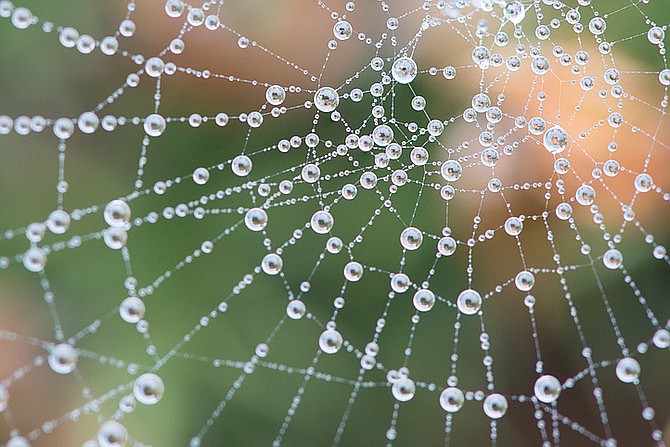 Facebook
Facebook
 X
X
 Instagram
Instagram
 TikTok
TikTok
 Youtube
Youtube

Dense Ground Fogs are a trademark of the onset of autumn along San Diego’s coastal strip. Fog materializes during the night and early morning hours when moist marine air that has settled in valleys and low areas is chilled below the dew point. These ground fogs are distinct from the low overcast (“marine layer”) that usually blankets the coastal zone on late spring and summer mornings.

Spider Webs, decorated with myriads of tiny dew droplets, are a beautiful sight on foggy autumn mornings. Look out for Orb Weaver webs in San Diego’s wild canyons, park areas, or in your own backyard. The spiders are fully grown and in abundance in the fall, and weave large, circular webs that can span several feet. These large spiders look scary but are harmless.
October’s Highest Tides, will occur the morning hours of the 7th, 8th and 9th, peaking at 6’7” on the 8th. Low-lying coastal areas might experience some flooding.
The New Moon is on Wednesday, October 6 and will be only 9% visible by the week’s end. The sunrise and sunset continue to get closer together until Daylight Savings Time, which is on November 7 this year. The sun rises at 6:47 am today (Oct 7) and sets at 6:24 pm. The daylength will be under 11 hours by the end of the month.
Now that it’s October, Deneb has replaced Vega as the zenith star of early dark evening (for skywatchers at mid-northern latitudes). Accordingly, Capricornus has replaced Sagittarius as the zodiacal constellation low in the south. This year, of course, Capricornus is overwhelmed by its two bright temporary residents: Jupiter and Saturn. The Great Square of Pegasus balances on its corner high in the east through much of the evening. Away from the Great Square’s left corner extends the main line of Andromeda, three 2nd-magnitude stars about as bright as those of the Square and spaced similarly far apart. (The three include the Square’s corner.) Spot Venus low in the southwest as early in twilight as you can. Then look lower right of it by some 12° (about a fist at arm’s length) for the thin crescent Moon. Binoculars help.
The above comes from the Outdoors listings in the Reader compiled by Jerry Schad, author of Afoot & Afield in San Diego County. Schad died in 2011. Planet information from SkyandTelescope.org.


Dense Ground Fogs are a trademark of the onset of autumn along San Diego’s coastal strip. Fog materializes during the night and early morning hours when moist marine air that has settled in valleys and low areas is chilled below the dew point. These ground fogs are distinct from the low overcast (“marine layer”) that usually blankets the coastal zone on late spring and summer mornings.

Spider Webs, decorated with myriads of tiny dew droplets, are a beautiful sight on foggy autumn mornings. Look out for Orb Weaver webs in San Diego’s wild canyons, park areas, or in your own backyard. The spiders are fully grown and in abundance in the fall, and weave large, circular webs that can span several feet. These large spiders look scary but are harmless.
October’s Highest Tides, will occur the morning hours of the 7th, 8th and 9th, peaking at 6’7” on the 8th. Low-lying coastal areas might experience some flooding.
The New Moon is on Wednesday, October 6 and will be only 9% visible by the week’s end. The sunrise and sunset continue to get closer together until Daylight Savings Time, which is on November 7 this year. The sun rises at 6:47 am today (Oct 7) and sets at 6:24 pm. The daylength will be under 11 hours by the end of the month.
Now that it’s October, Deneb has replaced Vega as the zenith star of early dark evening (for skywatchers at mid-northern latitudes). Accordingly, Capricornus has replaced Sagittarius as the zodiacal constellation low in the south. This year, of course, Capricornus is overwhelmed by its two bright temporary residents: Jupiter and Saturn. The Great Square of Pegasus balances on its corner high in the east through much of the evening. Away from the Great Square’s left corner extends the main line of Andromeda, three 2nd-magnitude stars about as bright as those of the Square and spaced similarly far apart. (The three include the Square’s corner.) Spot Venus low in the southwest as early in twilight as you can. Then look lower right of it by some 12° (about a fist at arm’s length) for the thin crescent Moon. Binoculars help.
The above comes from the Outdoors listings in the Reader compiled by Jerry Schad, author of Afoot & Afield in San Diego County. Schad died in 2011. Planet information from SkyandTelescope.org.
Comments